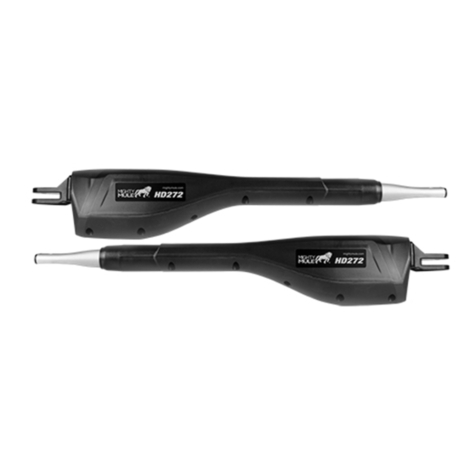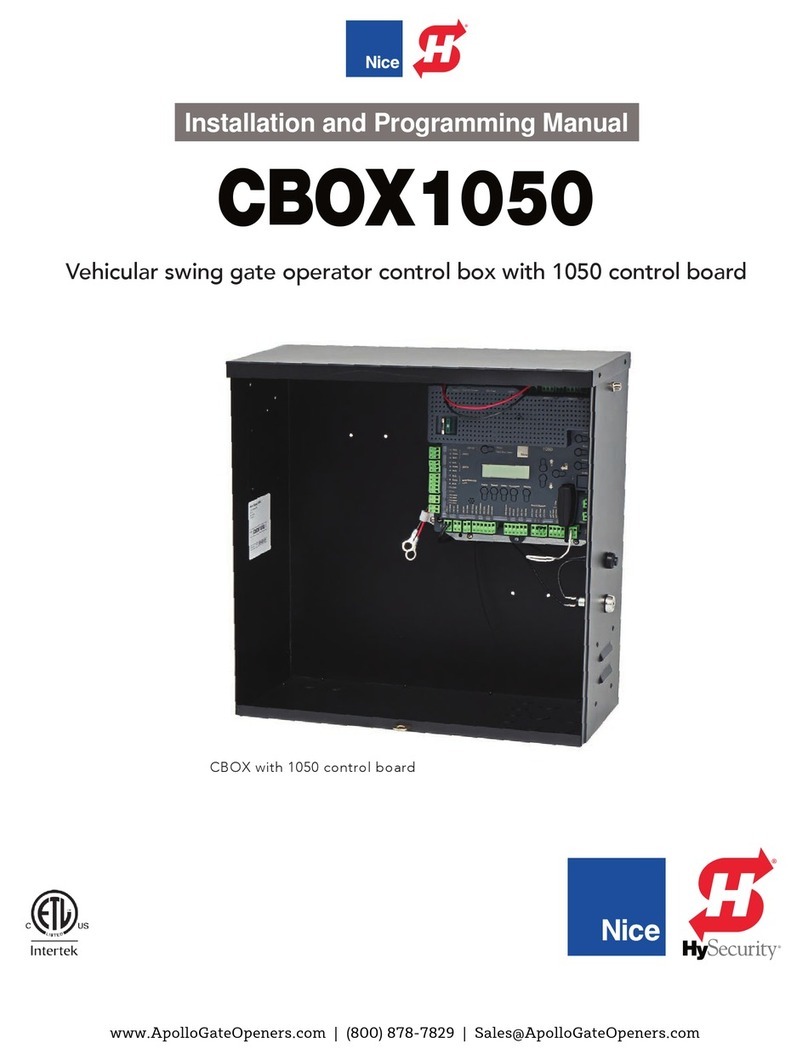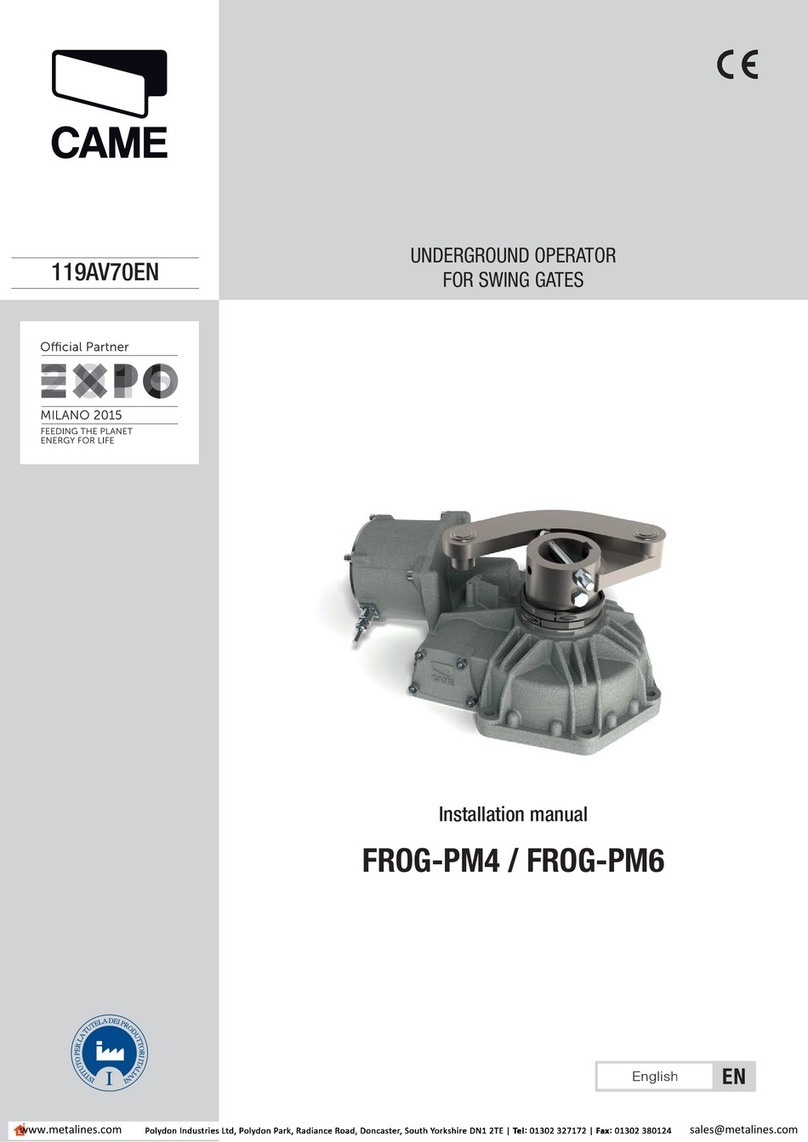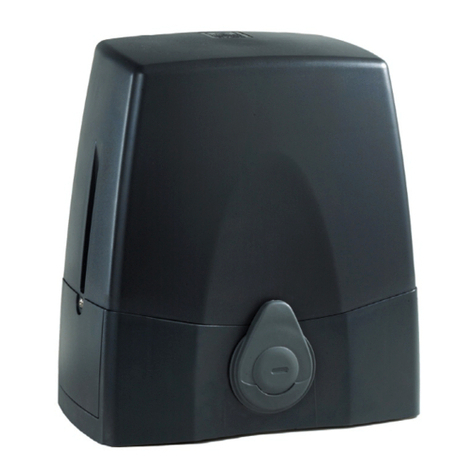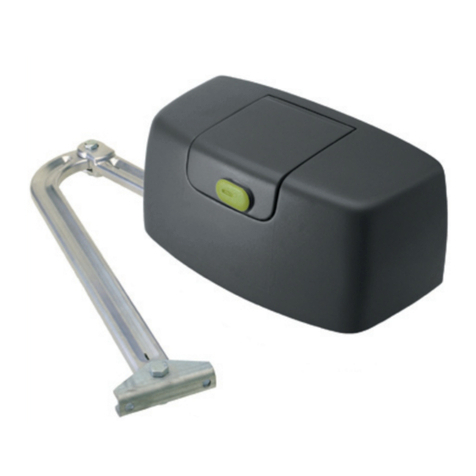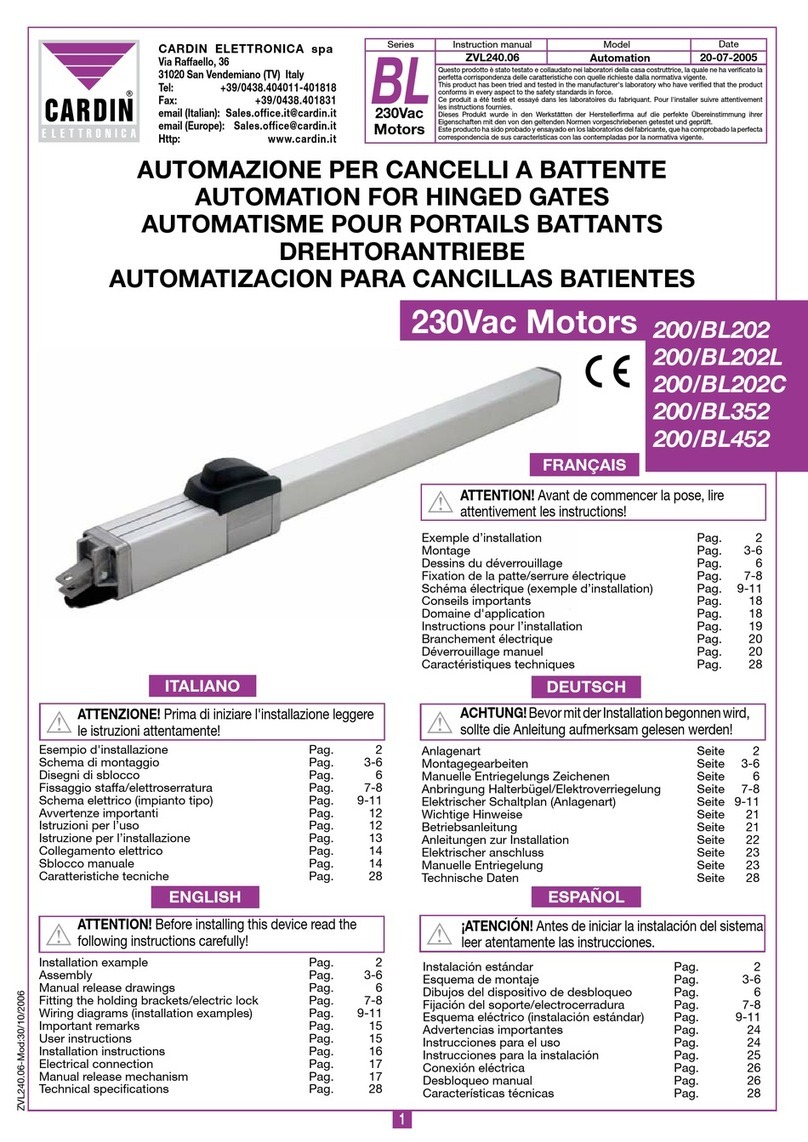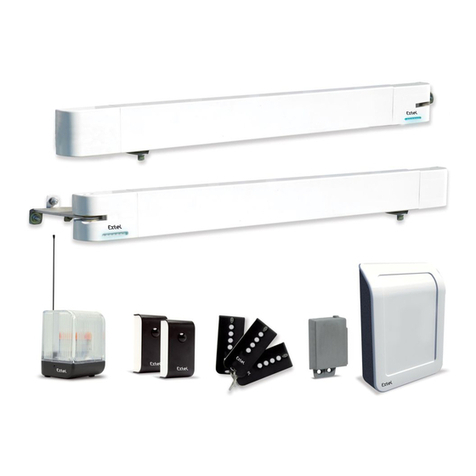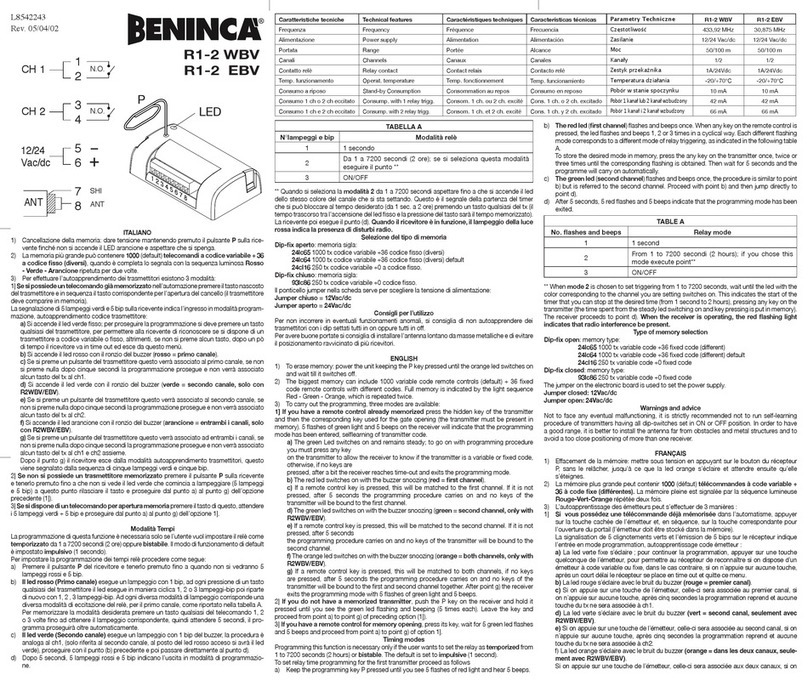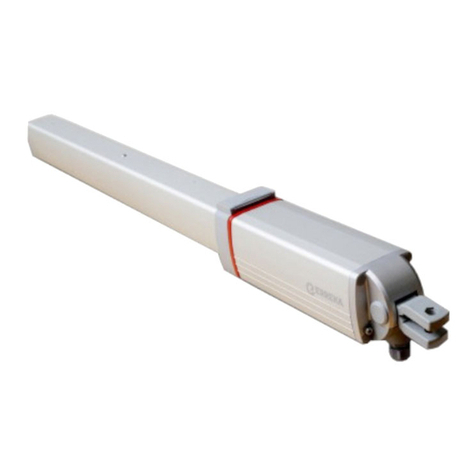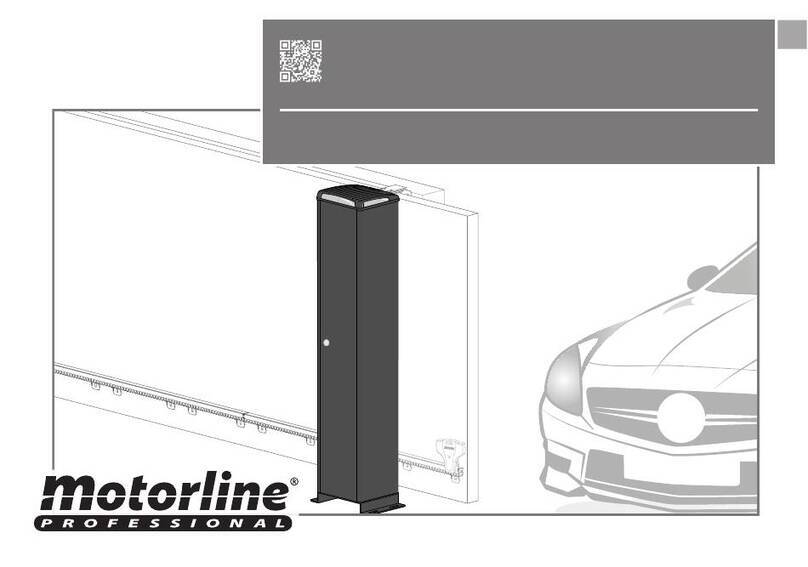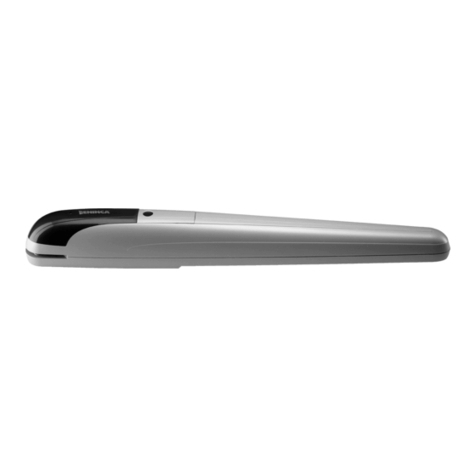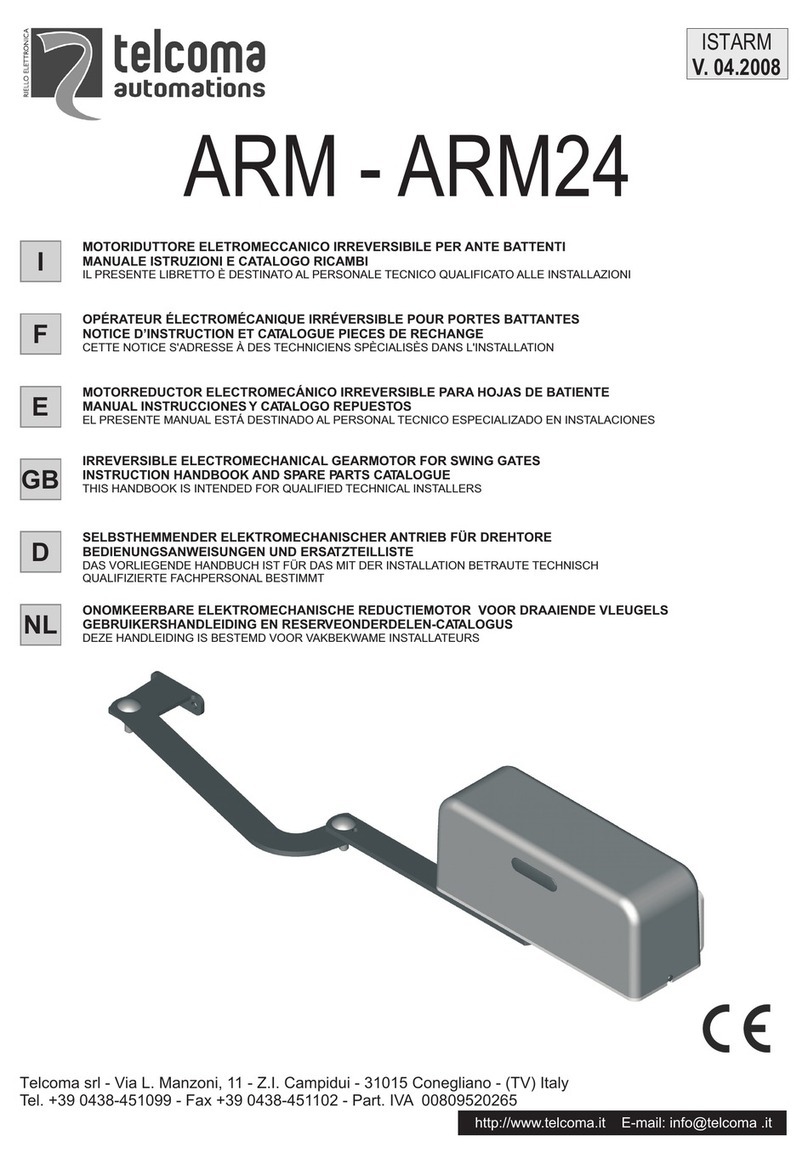
9
• Il presente manuale si rivolge a persone abilitate all'installazione di
"APPARECCHI UTILIZZATORI DI ENERGIA ELETTRICA" (ai sensi
della legge N.46 del 5.3.1990) e richiede una buona conoscenza
della tecnica, esercitata in forma professionale.
I materiali usati devono essere certificati e risultare idonei alle
condizioni ambientali di installazione.
• Le apparecchiature qui descritte dovranno essere destinate solo
all'uso per il quale sono state espressamente concepite:
"La motorizzazione di cancelli e portoni".
L’utilizzo dei prodotti e la loro destinazione ad usi diversi da quelli
previsti e/o consigliati, non è stata sperimentata dal costruttore,
pertanto i lavori eseguiti sono sotto la completa responsabilità
dell’installatore.
POSSIBILITÀ D'IMPIEGO
Il dispositivo è adatto alla movimentazione di cancelli a battente, ad
una o due ante. L'applicazione per tutti i modelli è possibile sia a sx
che a dx della luce passaggio.
Modelli di riferimento:
200/BL1924 Attuatore elettromeccanico 24V dc autobloccante per
ante fino a 2m, 150kg di peso per anta.
DESCRIZIONE TECNICA
- Motore 24V dc in corrente continua .
- Carter di copertura in plastica antiurto.
- Particolari sblocco in plastica rinforzata.
- Riduttore con ingranaggi in acciaio racchiusi in semigusci di
alluminio pressofuso.
- Il motoriduttore è fornito di due microinterruttori di finecorsa:
uno di chiusura "FCC" ed uno di apertura "FCA" (vedi schema
elettrico).
- Staffa supporto motore in acciaio zincato.
- Particolari braccio snodato in alluminio pressofuso verniciato.
- Lubrificazione a grasso fluido permanente.
ACCESSORI
980/XLSE01-1 - Elettroserrattura 12V ac-V83.
IMPORTANTE! Il motoriduttore è sprovvisto di limitatore di
coppia, pertanto utilizzare centralina a limitazione elettronica
della coppia con spinta massima in punta d'anta pari a 150N
(norme UNI 8612).
É responsabilità dell’installatore verificare le seguenti condizioni
di sicurezza:
1) L’installazione deve essere sufficientemente lontana dalla strada in
modo da non costituire pericolo per la circolazione.
2) L’operatore deve essere installato all’interno della proprietà ed il
cancello non deve aprirsi verso l’area pubblica.
3) Il cancello motorizzato é principalmente adibito al passaggio
di vetture. Dove possibile installare per pedoni un ingresso
separato.
4) Icomandidevonoesserepostiinvista,manonentro il raggio d’azione
del cancello. Inoltre quelli installati all’esterno devono essere protetti
da una sicurezza tale da prevenire l’uso non autorizzato.
5) É buona norma segnalare l’automazione con targhe di avvertenza
(simili a quella in figura) che devono essere
facilmente visibili.
Qualora l’automazione sia adibita al solo
passaggio di veicoli dovranno essere poste due
targhe di avvertenza di divietoditransitopedonale
(una all’interno, una all’esterno).
6) Rendere consapevole l’utente che bambini o
animali domestici non devono giocare o sostare
nei pressi del cancello. Se necessario indicarlo
in targa.
7) Qualora l’anta completamente aperta vada ad avvicinarsi ad una
struttura fissa bisogna lasciare uno spazio di 600mm nella zona
d’azione del braccio articolato.
Tale spazio deve essere protetto con una costa sensibile
antischiacciamento (vedi figura 1, dett.11)
8) Perqualsiasi dubbio a riguardo della sicurezzadell’installazione, non
procedere ma rivolgersi al distributore del prodotto.
AVVERTENZE PER L'UTENTE
Prima di eseguire qualsiasi operazione di pulizia o di manutenzione,
disinserire l'apparecchiatura dalla rete di alimentazione elettrica.
I comandi minimi che possono essere installati sono APERTURA-
STOP-CHIUSURA, tali comandi devono essere posti in un luogo
non accessibile a bambini o minori e fuori dal raggio d’azione
del cancello.
Durante la manovra si deve controllare il movimento del cancello
e azionare il dispositivo di arresto immediato (STOP) in caso di
pericolo. In caso di emergenza il cancello può essere sbloccato
manualmente utilizzando l'apposita chiave di sblocco in dotazione
(vedi sblocco manuale pag.10).
Controllare periodicamente lo stato di usura dei perni ed eventual-
mente ingrassare le parti in moto, usando lubrificanti che mantengano
uguali caratteristiche di attrito nel tempo e adatti a funzionare tra
-20 e +70°C.
In caso di guasto o anomalie di funzionamento staccare l'alimentazione
elettrica a monte dell'apparecchiatura e chiamare l'assistenza
tecnica.
Verificare periodicamente il funzionamento delle sicurezze (fotocellule
ecc.). Le eventuali riparazioni devono essere eseguite da personale
specializzato usando materiali originali e certificati.
L'uso dell'automazione non è idoneo all'azionamento in continuo,
bensì deve essere regolato in base ai vari modelli (vedi caratteristiche
tecniche pagina 20).
Prima di procedere all'esecuzione dell'impianto verificare che la
struttura da automatizzare sia in perfetta efficienza nelle sue parti fisse
e mobili e realizzata in conformità alla normativa vigente.
A tal fine accertarsi della sufficiente rigidità del telo cancello
(se necessario intervenire con rinforzi sulla struttura) e del buon
funzionamento dei perni (si consiglia comunque di lubrificare tutte
le parti in movimento usando lubrificanti che mantengano uguali
caratteristiche di attrito nel tempo e adatti a funzionare tra -20
e +70°C).
• Controllare i franchi di sicurezza tra parti fisse e parti mobili:
- lasciare uno spazio di 30mm minimo tra il cancello ed il pilastro
di supporto per tutta l’altezza e per tutto l’arco di apertura del
cancello;
- assicurarsi che lo spazio tra il cancello ed il pavimento non superi
mai 30mm per tutto l’arco di apertura del cancello.
• La superficie delle ante non deve presentare aperture tali da
permettere il passaggio della mano o del piede di persone.
• Controllare l'esatto posizionamento di perni e cerniere, il loro buon
stato di mantenimento e lubrificazione (importante che la cerniera
superiore e quella inferiore siano a piombo tra loro).
• Prevedere il percorso dei cavi secondo le necessità di applicazione
dei dispositivi di comando e sicurezza a norme UNI 8612 (ved.
impianto tipo fig.1 pag.2).
• Controllare che l’operatore sia proporzionato alle dimensioni
del cancello e alla frequenza d’uso (intermittenza di lavoro,
pag. 20).
ISTRUZIONI PER L'USO
ISTRUZIONI PER L'INSTALLAZIONE
APERTURA AUTOMATICA
NON AVVICINARSI
NON PERMETTERE A BAMBINI O AD
ANIMALI DOMESTICI DI SOSTARE NEL
RAGGIO D'AZIONE DEL CANCELLO
ATTENZIONE
AVVERTENZE IMPORTANTI AVVERTENZE IMPORTANTI AVVERTENZE IMPORTANTI
LEGGERE ATTENTAMENTE LE SEGUENTI AVVERTENZE PRIMA DI PROCEDERE
ALL’INSTALLAZIONE.PRESTARE PARTICOLAREATTENZIONE A TUTTELESEGNALAZIONI
DISPOSTE NEL TESTO. IL MANCATO RISPETTO DI QUESTE POTREBBE COMPROMETTERE
IL BUON FUNZIONAMENTO DEL SISTEMA.
CONSIDERAZIONI GENERALI DI SICUREZZA
